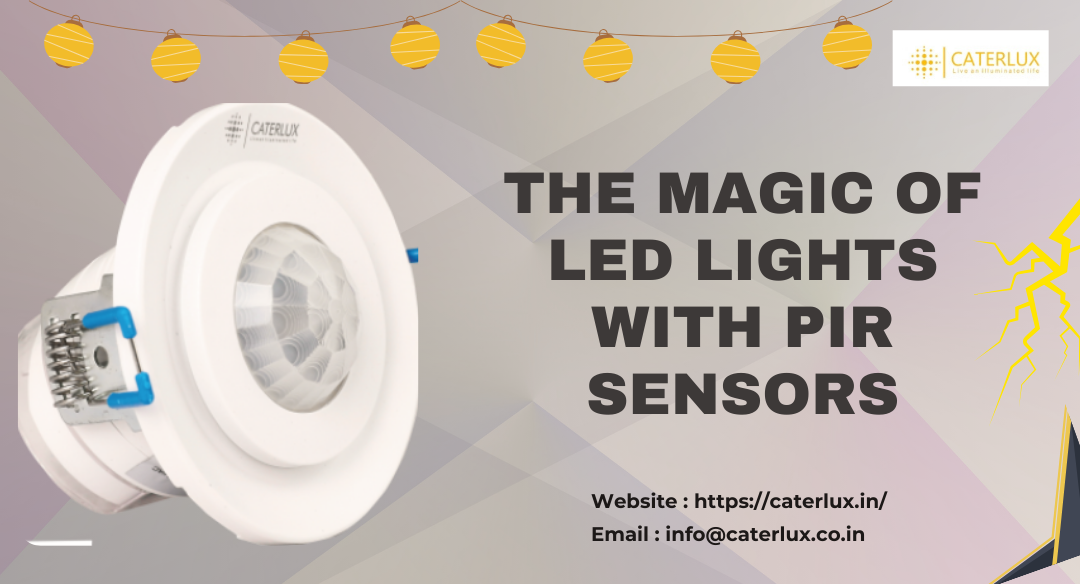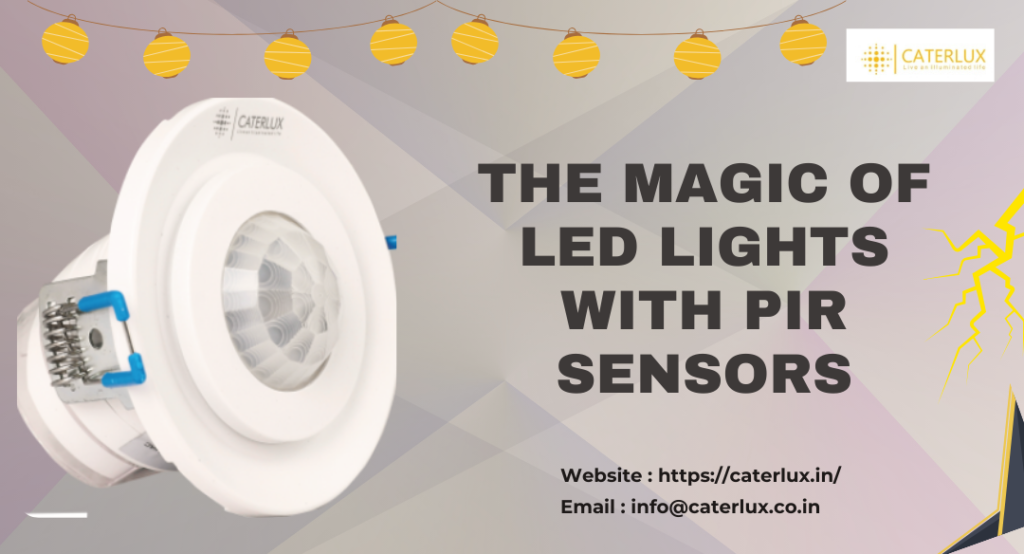
Exploring The Magic Of LED Lights With PIR Sensors
In today’s fast-paced world, where ease and efficiency are highly reign supreme, advancements and innovations in home decor always astound us. LED lights with PIR sensors are a brilliant example of innovation as they have changed the idea of how we light up our home. These sleek and modern gadgets have many valuable features that fit modern lives, such as making things safer and saving energy.
They are also known as “IR motion” sensors, “PIR” sensors, or “Pyroelectric” sensors. We generally use a PIR sensor to recognize movement to determine whether a person has moved into or out of the sensor’s range. So now let’s understand more about LED lights with PIR sensors and see how they can make our homes look better. Also, how Caterlux offers modern technology to enhance the efficiency and eco-friendliness of your home. Enhance your security system by upgrading to PIR sensors provided by Caterlux and embrace a more illuminated and intelligent future.

What Is A PIR Sensor?
A PIR sensor, also called a motion sensor, can detect the heat that closed things give off. It’s like having magic eyes that can sense things move! These LED lights with PIR sensors are perfect for energy-saving and can be easily associated with LED Lights wholesale dealers, along with the lightning solutions provider.
Smart lights that use less energy and keep places safe are just a few of the many things that these sensors are very useful for. That’s why a security camera or light that turns on when you walk by is probably the PIR sensor running its smart job! You can easily get LED lights with PIR sensors from wholesale lightning product suppliers.
Specifications Of PIR Sensors
PIR sensors are vital in various applications because they provide dependable motion detection. As a result of the following fundamental characteristics, they are indispensable:
PIR Sensors And Motion Sensor Detection: A motion sensor detects any movement, while a PIR motion sensor specifically relies on infrared radiation to detect heat emitted by objects. PIR sensors are a type of motion sensor offering enhanced accuracy in detecting human and animal movement based on heat signatures.
Sensor With Elements: The dual-element design improves sensitivity while lowering the number of false alarms caused by noise interference. As a result, PIR sensors can react reliably to human or warm object motions, providing a robust and trustworthy solution.
Supply Voltage: PIR sensors have a low working voltage of 5V, allowing them to provide energy efficiency and ease of integration into various electronic systems. Also, they have a low supply voltage. Because of this, they are appropriate for a wide variety of applications, including mobile devices powered by batteries.
Adjustable Time: PIR sensor applications benefit from more flexibility when they have an adjustable delay time. This function allows customers to tailor the reaction time to individual needs, optimizing performance in various settings.
Options For connection: Many contemporary PIR sensors come pre-installed with many different connection options, which enable them to be integrated with mobile devices and the internet. This feature provides enhanced remote monitoring and control possibilities, adding an additional degree of ease and accessibility. Along with this comes a lightning solution provider that helps with ease of connection.
Capabilities For Video: Some of the most modern PIR sensors can record video, expanding their utility beyond the typical motion detection capabilities. This characteristic makes them useful in surveillance systems, as they can provide both visual verification and motion-triggered alarms.
How Do PIR Sensors Work?
In the case of PIR sensors used in burglar alarms, a relay is a component of a circuit comprising two points connected. The PIR sensor will open the relay whenever it senses motion, breaking the circuit and sounding the alarm.
PIR sensors can function at the most fundamental level using positive differential change. In front of the lens are two slots sensitive to infrared light, and the range of detection is determined by the field of “vision” of these slots. The ambient level of infrared light measured in the room (naturally emitted by all things) is the same in both slots when the device is in the “idle” position. As soon as an item, person, or animal goes through the detecting area, it is detected by one of the slots before the other. This results in a positive differential change as the object passes through the region and a negative one as the thing departs the area.
When the PIR sensor detects movement, it sends a message to the alarm panel and sounders, depending on whether or not the alarm is activated. These differentials include information. It is essential to enclose the PIR sensor itself inside a material capable of mitigating the effects of external factors such as temperature or humidity, such as silicon or metals.
Precisely, What Does A PIR Sensor Pick Up On?
Passive infrared sensors, often known as PIR sensors, can detect infrared radiation released by objects. To be more specific, they can detect variations in temperature, such as those brought on by the movement of animals or people. As a result, they are well suited for use in applications dealing with energy-efficient lighting and security systems.
Advantages Of PIR Sensors
Energy Efficiency: PIR sensors are more energy efficient than other motion sensors, making them an environmentally friendly option for a variety of applications.
Affordability And Cost-Effectiveness: PIR sensors are inexpensive and provide a cost-effective and affordable solution without sacrificing performance.
Installation And Configuration: Simple PIR sensors are user-friendly and can be readily installed and configured even by novices since the setup procedure is simple and easy.
User Interface: LED Lights with PIR sensors have an easy-to-use interface and need very little calibration, which ensures a hassle-free experience.
Immediate Motion Detection: PIR sensors can detect and respond to motion within their detection range promptly; they can provide rapid reaction times, which contribute to increased security and automation.
Disadvantages Of PIR Sensors
Limited Detection Range: PIR sensors have a limited detection range, meaning they are only suited for use in certain smaller areas or spaces.
Line Of Sight Requirement: These sensors must have a straight line of sight to the region being monitored. This requirement may restrict their efficacy in some circumstances.
Sensitivity To Temperature: PIR sensors may be affected by sudden variations in temperature in the surroundings, which can result in false positives or false negatives, which can have a detrimental impact on their dependability.
Single Sensing Mode: PIR sensors only have one sensing mode, which focuses on changes in heat signatures. This mode only provides a limited amount of information concerning motion that has been detected.
How Long Do Infrared (PIR) Sensors Last?
PIR sensors are determined by several variables, including use and quality. Generally speaking, good-quality PIR sensors may persist for a significant amount of time and provide dependable performance. When incorporating PIR sensors into LED lighting systems, choosing a reputable Custom Light Manufacturing Company is essential. This will guarantee that the sensors will last for a long time and provide the best possible performance.
Conclusion
LED lights with PIR sensors are a major home technology advancement. These lights are safe, energy-efficient, and convenient. These sensors can detect infrared radiation from living things to detect movement more accurately. Their dual-element design boosts sensitivity and reduces false alarms, making them reliable for many applications.
PIR sensors detect motion immediately within their range. They provide energy efficiency, economy, installation ease, and fast reaction times. However, they have various limitations, including a limited detecting range, a line-of-sight requirement, and temperature sensitivity.
Use and quality affect PIR sensors’ lifespan, yet some are high-quality and can work reliably for an extended period. PIR sensors in LED lighting systems must be from reputable suppliers to ensure longevity and functionality. You can get LED lights with PIR Sensors from the reputed LED light manufacturers in India.



